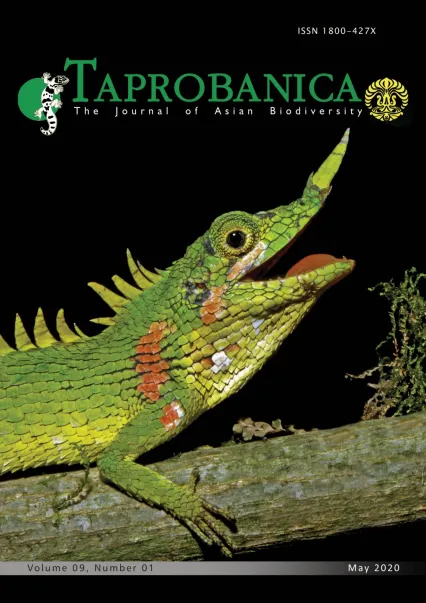

v9i1.224
Volume 9 | Number 1 | May 2020
Major Article
ISSN: 1800-427X (printed)
eISSN: 1800-427X (online)
DOI:10.47605/tapro.v9i1.224
Submitted date: 29 February 2019
Accepted date: 05 May 2020
Published date: 21 May 2020
Pp. 83–102, pls. 30–36.
A NEW SPECIES OF Dendrelaphis BOULENGER, 1890 (REPTILIA : COLUBRIDAE) FROM THE WET ZONE OF SRI LANKA WITH A REDESCRIPTION OF Dendrelaphis bifrenalis (BOULENGER, 1890)
A. Dineth Danushka, A. Suneth Kanishka, A.A. Thasun Amarasinghe*, Gernot Vogel & Sampath S. Seneviratne
*Corresponding author. E-mail: thasun@rccc.ui.ac.id
Abstract
Examination of the Dendrelaphis bifrenalis populations on Sri Lanka showed that there are two populations that are morphologically different from each other. One population is distributed only in the wet zone forests (hereafter treated as wet zone population), while the other population occurs widely in the dry zone and intermediate zones (hereafter dry zone population). The type series of D. bifrenalis consist of 3 specimens from which the specimen representing the dry zone population was chosen as lectotype, and the wet zone population is described here as a new species. It clearly differs from D. bifrenalis by having a shorter snout, orbit diameter 103–114% of eye–nostril length (vs 77–95%), and larger eye, orbit diameter 21–23% of head length (vs 17–20%). Furthermore it differs by having a temporal stripe stopping just beyond the neck (vs continues behind neck), the absence of black transverse dorsolateral bars on the anterior 1/4th of body (vs prominent), a narrow and pointed snout (vs broad and flat), a divided nasal (vs single), and a ventrolateral stripe continuing up to the tail (vs stopping at the level of the anal plate). This morphological differentiation is supported by the divergence in the mitochondrial NADH dehydrogenase subunit 4 (ND4) region separating clearly with the divergence of 1.70±0.35%. Also, here we resurrect D. effrenis (Werner, 1909) as a valid species, and D. sinharajensis as a junior synonym of it. The holotype of D. sinharajensis was chosen as the neotype of D. effrenis to stabilize nomenclature, and to make it an objective synonym. The third and fourth known specimens of this rare species are reported. A key of the species of the genus Dendrelaphis in Sri Lanka is provided.
Key words : Holotype, island biogeography, lectotype, neotype, syntype, systematic, taxonomy
Section Editor: Ivan Ineich
LSID:urn:lsid:zoobank.org
eISSN: 1800-427X (online)
DOI:10.47605/tapro.v9i1.224
Submitted date: 29 February 2019
Accepted date: 05 May 2020
Published date: 21 May 2020
Pp. 83–102, pls. 30–36.
A NEW SPECIES OF Dendrelaphis BOULENGER, 1890 (REPTILIA : COLUBRIDAE) FROM THE WET ZONE OF SRI LANKA WITH A REDESCRIPTION OF Dendrelaphis bifrenalis (BOULENGER, 1890)
A. Dineth Danushka, A. Suneth Kanishka, A.A. Thasun Amarasinghe*, Gernot Vogel & Sampath S. Seneviratne
*Corresponding author. E-mail: thasun@rccc.ui.ac.id
Abstract
Examination of the Dendrelaphis bifrenalis populations on Sri Lanka showed that there are two populations that are morphologically different from each other. One population is distributed only in the wet zone forests (hereafter treated as wet zone population), while the other population occurs widely in the dry zone and intermediate zones (hereafter dry zone population). The type series of D. bifrenalis consist of 3 specimens from which the specimen representing the dry zone population was chosen as lectotype, and the wet zone population is described here as a new species. It clearly differs from D. bifrenalis by having a shorter snout, orbit diameter 103–114% of eye–nostril length (vs 77–95%), and larger eye, orbit diameter 21–23% of head length (vs 17–20%). Furthermore it differs by having a temporal stripe stopping just beyond the neck (vs continues behind neck), the absence of black transverse dorsolateral bars on the anterior 1/4th of body (vs prominent), a narrow and pointed snout (vs broad and flat), a divided nasal (vs single), and a ventrolateral stripe continuing up to the tail (vs stopping at the level of the anal plate). This morphological differentiation is supported by the divergence in the mitochondrial NADH dehydrogenase subunit 4 (ND4) region separating clearly with the divergence of 1.70±0.35%. Also, here we resurrect D. effrenis (Werner, 1909) as a valid species, and D. sinharajensis as a junior synonym of it. The holotype of D. sinharajensis was chosen as the neotype of D. effrenis to stabilize nomenclature, and to make it an objective synonym. The third and fourth known specimens of this rare species are reported. A key of the species of the genus Dendrelaphis in Sri Lanka is provided.
Key words : Holotype, island biogeography, lectotype, neotype, syntype, systematic, taxonomy
Section Editor: Ivan Ineich
LSID:urn:lsid:zoobank.org
- List of Articles & Contents





